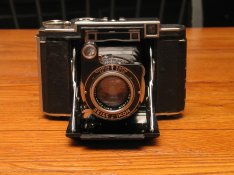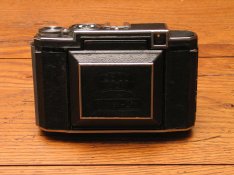The 530/16 is among the first of the "Super" Ikonta/Ikomat cameras made by Zeiss Ikon.
The inside marking of "6x9" with a picture of the film box told the user what film to purchase. Instead of marketing the film as "120 roll film," Zeiss Ikon marketed its film as "BII8 - 6x9."
I believe the Ikomat name was for the U.S. while the Ikonta name was used in Europe. In any case, Zeiss Ikon (not Zeiss) dropped the Ikomat name at some point, reviving the name decades later for a simple Instamatic camera.
The 530/16 has separate eyepieces for focusing and viewing. Its replacement, the 532/16, unified the viewfinder and rangefinder. The postwar 532/16 eventually added a coated Tessar, and the Super Ikonta BX 533/16 added a selenium meter (and considerable weight and size).
Typically, a Super Ikonta B will require shutter service, cleaning of the rangefinder and viewfinder optics and relubrication of the lens helical. Once the rangefinder is calibrated, it should never fall out of calibration (except for physical damage) because the rotating wedge prism doesn't depend on pivoting mirrors or prisms. The main rangefinder prism remains fixed, and the only moving parts are the rotating prisms. It's mechnically simple and durable.
All of the Super Ikonta B cameras had an f/2.8 8cm/80mm lens. Many people, including me, think that Zeiss pushed the Tessar design too far at f/2.8 for this focal length.
Regardless, it's an easy camera to use. I hold it like I would a 35mm SLR - lens bed sitting on the palm of my left hand, using my thumb to focus the camera.
It has an autoframing mechanism, and you get only 11 shots per roll. The positioning of the film for each frame is set by a small brass disk under the frame counter.
Below:
530/16, 532/16 and 533/16.
Notice that Zeiss Ikon enlarged the viewfinder for the 532/16.
I shot with the 532/16 a few weeks ago. I always have fun with this camera.






